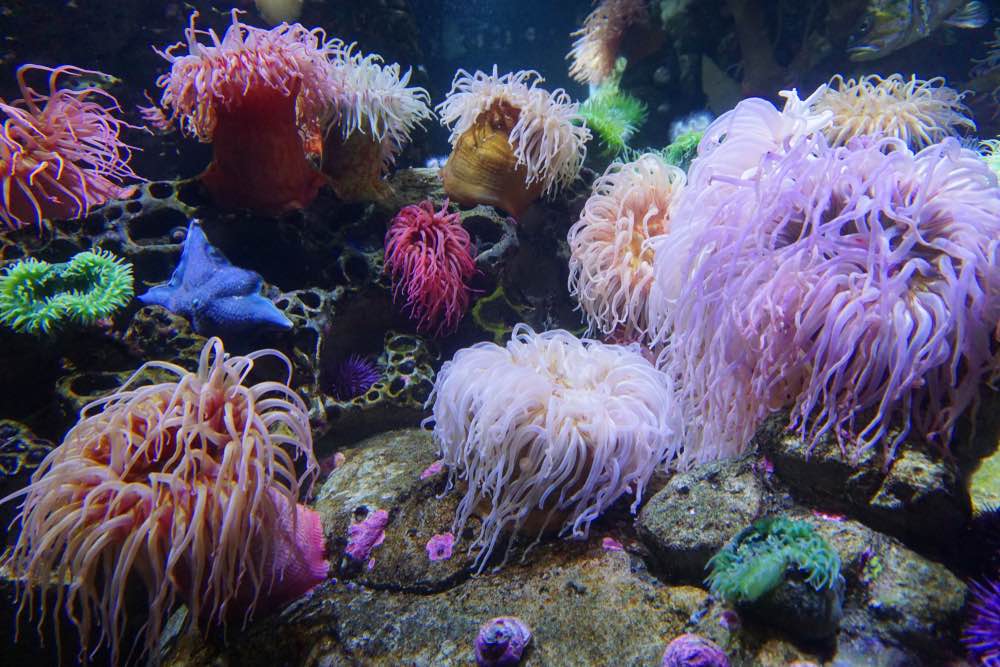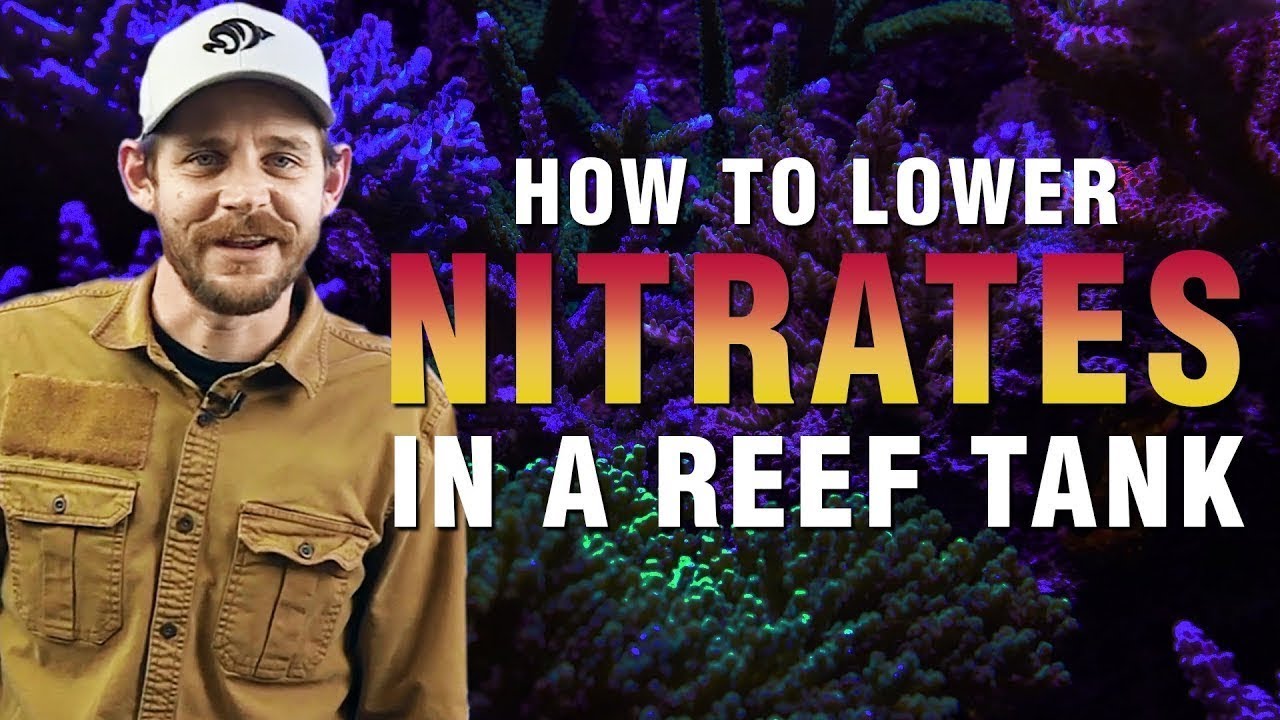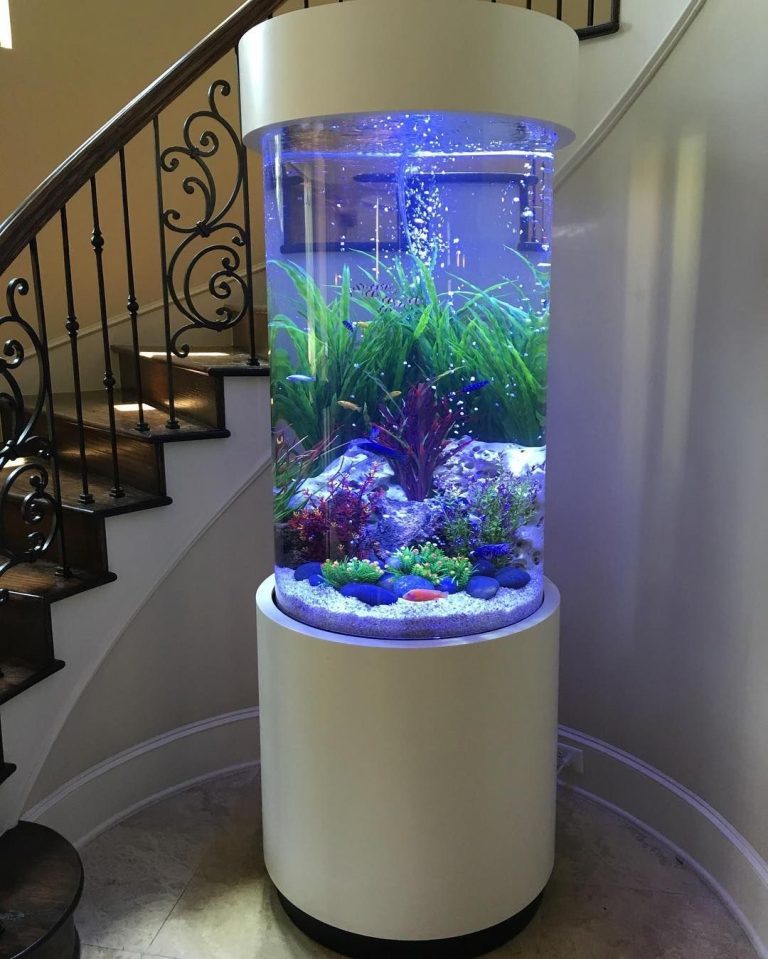How to Effectively Lower Nitrates in Your Saltwater Aquarium
To lower nitrates in a saltwater aquarium, perform regular water changes and use nitrate-removing media like activated carbon or specialized resins. Safeguarding the health of your saltwater aquarium requires maintaining optimal water conditions.
Excessive nitrates can lead to a host of problems, including algae growth and stress for your aquatic inhabitants. By diligently performing water changes and utilizing nitrate-removing media such as activated carbon or specialized resins, you can effectively decrease nitrates in your saltwater aquarium.
Ensuring a clean and balanced environment for your marine life promotes their well-being and longevity.

Credit: www.hepper.com
What Are Nitrates And Why Are They A Problem?
Overview Of Nitrates In Saltwater Aquariums
Nitrates are a natural byproduct of the nitrogen cycle in saltwater aquariums. When fish produce waste and uneaten food decays, it releases ammonia, which is converted to nitrites by beneficial bacteria. These nitrites are then converted into nitrates, which are less harmful to fish but can still pose a threat if they accumulate to high levels.
The Negative Impact Of High Nitrate Levels On Aquarium Inhabitants
Excessive nitrates in a saltwater aquarium can have detrimental effects on the health of its inhabitants. Some key points to consider include:
- High nitrate levels can lead to poor water quality, causing stress and compromising the immune system of fish and invertebrates.
- Fish may experience difficulty breathing, reduced activity levels, and decreased appetite in an environment with high nitrate levels.
- Invertebrates such as corals, anemones, and shrimp can suffer tissue damage, color loss, and stunted growth when exposed to elevated nitrate concentrations.
- Increased nitrates can also contribute to the growth of nuisance algae, robbing corals and other photosynthetic organisms of necessary light and nutrients.
To ensure the well-being of your saltwater aquarium inhabitants, it is crucial to keep nitrate levels within a safe range.
Linking Nitrates To Poor Water Quality And Health Issues
High nitrate levels are an indicator of poor water quality in a saltwater aquarium. Here are some key points to highlight the connection between nitrates, water quality, and health issues:
- Elevated nitrate concentrations can result from overstocking fish, overfeeding, inadequate filtration, or infrequent water changes.
- Poor water quality due to high nitrate levels can increase the risk of diseases and infections among aquarium inhabitants.
- Nitrate buildup can lead to reduced oxygen levels in the water, putting additional stress on fish and invertebrates.
- Fish may exhibit symptoms such as fin rot, increased mucus production, and greater susceptibility to parasites when nitrate levels are too high.
- Regular testing and proactive measures to lower nitrates, such as partial water changes and maintenance of proper filtration systems, are essential to maintain optimal water quality and prevent health issues.
By understanding the negative impact of high nitrate levels on saltwater aquariums, you can take the necessary steps to create a healthy and thriving aquatic environment for your beloved fish and invertebrates.
Assessing Nitrate Levels In Your Saltwater Aquarium
Regularly testing for nitrate levels in your saltwater aquarium is incredibly important for the health and well-being of your aquatic pets. High levels of nitrates can be detrimental to fish and other marine life, leading to a range of issues including poor growth, decreased immune function, and even death.
By monitoring and maintaining appropriate nitrate levels, you can create a thriving and balanced ecosystem for your underwater friends. So let’s dive into the key aspects of assessing nitrate levels in your saltwater aquarium.
Importance Of Regular Testing For Nitrate Levels
Testing for nitrate levels should be a routine part of your aquarium maintenance routine. Here are a few reasons why regular testing is crucial:
- Nitrate is a common byproduct of the nitrogen cycle in aquariums. Monitoring nitrate levels gives you insights into the efficiency of the biological filtration process and helps ensure that toxic nitrogen compounds are being converted into less harmful forms.
- High nitrate levels can lead to poor water quality, negatively impacting the overall health of your fish and invertebrates. Regular testing allows you to identify and address high nitrate levels promptly before they cause harm.
- Nitrate levels can fluctuate due to various factors, including feeding habits, waste accumulation, and water changes. By testing regularly, you can monitor these changes and make appropriate adjustments to maintain a stable and healthy environment.
- Monitoring nitrate levels is an essential part of preventive care. Catching and addressing nitrate issues early on can prevent more significant problems in the future, such as algae blooms and compromised water quality.
Choosing The Right Nitrate Testing Kit
When it comes to selecting a nitrate testing kit, accuracy and ease of use are key. Consider the following factors when choosing a kit:
- Accuracy: Opt for a kit that provides reliable and precise measurements. Look for reviews and ratings to ensure that the kit has a good reputation for accuracy.
- Easy-to-follow instructions: Select a testing kit that comes with clear and concise instructions. This will make the testing process simpler and less prone to errors.
- Testing method: Nitrate testing kits can utilize different testing methods, including test strips, liquid reagents, and electronic meters. Choose a method that suits your preference and provides accurate results.
- Cost: Consider your budget when selecting a nitrate testing kit. Keep in mind that investing in a quality kit may provide more accurate results in the long run, leading to better aquarium health.
Interpreting Nitrate Test Results Accurately
Accurate interpretation of nitrate test results ensures you can take the appropriate actions to maintain a healthy and balanced aquarium environment. Here are a few key points to keep in mind when interpreting your nitrate test results:
- Nitrate levels are generally measured in parts per million (ppm). The desired nitrate level for most saltwater aquariums falls within the range of 0-20 ppm.
- Levels below 10 ppm are considered ideal for most marine species, promoting optimal health and growth.
- If nitrate levels exceed 20 ppm, it is crucial to take action to lower them. This can be achieved through various methods such as regular water changes, increasing biological filtration, or implementing strategies to reduce organic waste in the aquarium.
- Monitoring nitrate levels over time helps identify patterns and potential issues. Tracking trends in nitrate levels allows you to make informed decisions regarding the management of your aquarium’s health.
Regular assessment of nitrate levels in your saltwater aquarium is vital for the overall well-being of its inhabitants. By adopting a proactive approach to testing, choosing the right kit, and accurately interpreting the results, you can create a thriving and beautiful underwater ecosystem that brings joy and fascination to your home.
Causes Of High Nitrates In Saltwater Aquariums
Aquarium enthusiasts understand the importance of maintaining water quality for the health of their saltwater aquarium inhabitants. One crucial aspect of water quality management is addressing high nitrate levels. Excess nitrates can negatively impact the overall well-being of the aquarium ecosystem, leading to health issues for fish and coral.
In this section, we will explore the three main causes of high nitrates in saltwater aquariums.
The Nitrogen Cycle And Nitrate Production:
- The nitrogen cycle is a natural process that occurs in fish tanks, converting ammonia (released through fish waste and decaying matter) into less harmful substances like nitrite and eventually nitrate.
- Nitrates are the final product of the nitrogen cycle, and while they are less toxic compared to ammonia and nitrites, they can accumulate to harmful levels if not properly managed.
- A well-established biological filtration system with beneficial bacteria is essential to efficiently convert ammonia and nitrites into nitrates.
- However, high fish load or poor filtration may disrupt the nitrogen cycle and result in excess nitrate production.
Overfeeding And Its Contribution To Excess Nitrates:
- Overfeeding is a common mistake made by aquarium owners, often unintentionally. Excess food that is left uneaten by fish ends up decomposing, releasing ammonia, and eventually increasing the nitrate levels.
- Fish should only be fed the amount they can consume within a few minutes to prevent unintentional overfeeding.
- Using a feeding schedule and monitoring the feeding habits of the fish is important to avoid excessive nitrate production.
- Regularly cleaning the tank, removing uneaten food, and maintaining a proper feeding routine can help prevent nitrate buildup.
The Role Of Decaying Organic Matter In Nitrate Buildup:
- Organic matter, such as dead fish, decaying algae, or plant material, can contribute to the accumulation of nitrates.
- Without prompt removal, decaying matter breaks down, releasing ammonia, which is then converted into nitrate.
- A regular maintenance routine that involves removing dead organisms and debris, as well as siphoning the substrate, can minimize nitrate production.
- Ensuring proper water circulation and investing in a protein skimmer can also help in removing organic matter before it decomposes.
By understanding the causes of high nitrates in saltwater aquariums, aquarium owners can take proactive measures to maintain optimal water quality and ensure the long-term health and success of their beloved aquatic inhabitants.
Enhancing Aquarium Filtration System
Maintaining proper water quality is essential for the health and longevity of your saltwater aquarium. One crucial aspect of achieving optimal water conditions is designing an effective filtration system. In this section, we will discuss the key factors to consider when choosing a filtration system, the benefits of using a protein skimmer, and how to maximize the efficiency of biological filtration.
Choosing The Appropriate Filtration System For Nitrate Removal
When it comes to selecting a filtration system for nitrates removal in your saltwater aquarium, here are the key points to consider:
- Sump filtration: Installing a sump system can significantly enhance the filtration capacity of your aquarium. It provides extra space for various types of filtration media, such as activated carbon and nitrate-reducing resins.
- Mechanical filtration: Utilizing mechanical filtration methods like filter socks or power filters can help trap large particulate matter, preventing them from decomposing into nitrates.
- Chemical filtration: Incorporating chemical filtration media, such as specialized zeolite or phosphate removers, can target specific pollutants and help reduce nitrate levels.
- Biological filtration: A robust biological filtration system plays a vital role in nitrate reduction. Utilize live rock and live sand to host beneficial bacteria, which convert harmful ammonia and nitrite into less toxic nitrate.
The Benefits Of Using A Protein Skimmer
Including a protein skimmer in your aquarium setup offers several advantages:
- Organic waste removal: Protein skimmers excel at removing dissolved organic compounds, such as excess proteins, before they decompose and contribute to nitrate buildup.
- Enhanced oxygen exchange: By creating tiny bubbles and increasing surface area, protein skimmers promote greater oxygen exchange, helping maintain optimal oxygen levels in the aquarium.
- Prevention of algae outbreaks: By removing excess nutrients from the water, protein skimmers reduce the availability of food for algae growth, thus minimizing the chance of unsightly algae outbreaks.
Maximizing The Efficiency Of Biological Filtration
To ensure your biological filtration system efficiently removes nitrates from your saltwater aquarium, consider the following points:
- Provide adequate surface area: Use porous materials like live rock or bio balls to provide a larger surface area for beneficial bacteria colonization.
- Maintain stable water parameters: Fluctuating water conditions, such as ph or salinity, can disrupt the delicate balance of the biological filter. Regular water testing and appropriate adjustments are crucial to maintain stable conditions.
- Avoid overfeeding: Overfeeding your fish can result in excess organic waste, leading to increased nitrate production. Feed your fish only what they can consume in a few minutes to prevent unnecessary nitrate buildup.
- Regular maintenance: Periodically clean any debris or detritus that may accumulate in your filtration system, as this can hinder the efficiency of the biological filter.
By carefully selecting the appropriate filtration system, utilizing a protein skimmer, and maximizing the efficiency of biological filtration, you can significantly lower nitrates in your saltwater aquarium. Maintaining optimal water quality will not only benefit the overall health of your fish and corals but also contribute to the aesthetic appeal of your aquarium setup.
Optimizing Aquarium Maintenance Practices
Nitrates are a common issue in saltwater aquariums, as they can build up over time and negatively impact the health of your fish and coral. Optimizing your aquarium maintenance practices is crucial in order to keep nitrates at a safe level.
We’ll explore three important aspects of aquarium maintenance that can help lower nitrates effectively. By conducting regular water changes, properly cleaning your gravel, and utilizing chemical filtration media, you can create a healthier and more balanced environment for your saltwater aquarium inhabitants.
Conducting Regular Water Changes To Dilute Nitrates:
- Water changes are a fundamental aspect of aquarium maintenance that helps maintain water quality and reduce nitrates.
- By replacing a portion of the aquarium water with fresh, clean water, you can dilute the concentration of nitrates and remove other accumulated toxins.
- Aim for a water change of 10-20% every 2-4 weeks, depending on the size of your tank and the nitrate levels. This frequency will help keep nitrates in check, promoting a healthier aquatic habitat.
Proper Gravel Cleaning Techniques To Remove Accumulated Waste:
- Over time, uneaten food, fish waste, and decaying plant matter can settle in the gravel bed of your aquarium, becoming a source of nitrates.
- Using a gravel vacuum, gently and systematically clean the substrate to remove any accumulated waste material.
- Ensure that you don’t disturb the beneficial bacteria living in the gravel, as they play an essential role in the nitrogen cycle.
- Aim to clean the gravel once a month using a siphon or vacuum, focusing on areas with visible debris.
Utilizing Chemical Filtration Media To Absorb Nitrates:
- Chemical filtration media, such as specialized resins or activated carbon, can effectively absorb nitrates from the aquarium water.
- Place the chemical media in a filter compartment or a specialized filter media bag within your filtration system, ensuring proper water flow through the media.
- Replace the chemical media according to the manufacturer’s instructions to maintain its effectiveness in reducing nitrate levels.
- Additionally, make sure to use chemical filtration along with other maintenance practices for optimum results in nitrate reduction.
By following these aquarium maintenance practices, you can significantly lower nitrates in your saltwater aquarium, promoting the health and well-being of your fish and coral. Regular water changes, proper gravel cleaning, and the use of chemical filtration media all work together to create a balanced and thriving aquatic environment.
Remember to monitor your nitrate levels regularly and adjust your maintenance routine as needed. With a little effort and dedication, you can provide your saltwater tank with the optimal conditions it deserves.
Limiting Nitrate Sources
Controlling feeding habits to reduce organic waste:
- Feed your fish and other aquarium inhabitants in moderation to avoid overfeeding.
- Remove any uneaten food within a few minutes to prevent it from decomposing and causing nitrate buildup.
- Consider using an automatic feeder to ensure consistent and measured feeding quantities.
- Provide a varied diet for your fish, including both dry and live foods, to minimize waste.
Minimizing the introduction of excess nutrients from additives:
- Research and choose aquarium additives carefully, opting for those with low levels of nitrates.
- Follow the recommended dosage instructions when adding any supplements or fertilizers.
- Perform regular water testing to monitor nutrient levels and adjust additive use accordingly.
- Consider using natural alternatives, such as live plants, to help manage nitrogen levels in the aquarium.
Managing livestock population to prevent overstocking issues:
- Start with a conservative number of fish and gradually add more over time, allowing the biological filtration to adjust.
- Take into account the size and needs of each species when determining the appropriate number to keep.
- Provide sufficient space for each fish to swim freely and establish territories.
- Regularly monitor water quality and behavior of the fish to ensure they are thriving.
By adopting these practices, you can effectively limit nitrate sources in your saltwater aquarium and create a healthier environment for your aquatic pets.
Establishing A Nitrate Monitoring Routine
Setting up a schedule for regular nitrate testing:
- Weekly testing: Perform a nitrate test every week to ensure a consistent monitoring routine.
- Preferred timing: Strive to conduct the test on the same day and time each week to eliminate any variations that may occur over time.
- Record keeping: Document the results of each test to track any changes in nitrate levels over time.
Keeping track of nitrate levels over time:
- Detailed records: Maintain a logbook or spreadsheet to record nitrate levels from each testing session.
- Include dates: Include the date of each test to create a chronological record of your monitoring efforts.
- Graphical representation: Consider creating a line graph to visually depict the fluctuations in nitrate levels over time.
Identifying patterns or changes in nitrate levels:
- Comparative analysis: Compare the results of each test to identify any recurring patterns or significant changes in nitrate levels.
- Day-to-day variations: Keep an eye out for daily fluctuations in nitrate levels, as this can indicate irregularities in the aquarium’s environment.
- Cause and effect: Connect any changes in nitrates to potential factors such as water changes, feeding habits, or the addition of new livestock.
By establishing a nitrate monitoring routine, you can effectively track the levels in your saltwater aquarium over time. Regular testing and record-keeping enable you to identify any patterns, changes, or issues that may arise, allowing you to take appropriate action to maintain a healthy aquatic environment for your marine life.
Balancing Nutrient Levels For Healthy Aquarium
Maintaining a balanced ecosystem in your saltwater aquarium is crucial for the health and well-being of your aquatic life. As a responsible aquarium owner, you must actively monitor and control nutrient levels to ensure a thriving environment for your marine animals.
In this section, we will discuss the importance of maintaining a balanced ecosystem, as well as how to monitor other water parameters and make necessary adjustments to feeding and maintenance practices.
The Importance Of Maintaining A Balanced Ecosystem
- A balanced ecosystem is essential for the overall health and longevity of your aquarium inhabitants.
- High nitrate levels can lead to various issues such as poor water quality, stunted growth, and increased susceptibility to diseases.
- By maintaining a balanced nitrogen cycle, you can effectively lower nitrates and provide a healthier environment for your saltwater fish and invertebrates.
Monitoring Other Water Parameters To Ensure Stability
- Regularly test your aquarium water for ammonia, nitrite, ph, and salinity levels to ensure they are within the appropriate ranges.
- Invest in a reliable water testing kit and perform tests at least once a week.
- Aim for an ammonia and nitrite level of zero, a ph level between 8.1 and 8.4, and a salinity range of 1.023 to 1.026.
Adjusting Feeding And Maintenance Practices As Necessary
- Overfeeding can result in excess waste and increased nitrate levels. Feed your fish only what they can consume in a few minutes, and remove any uneaten food.
- Regular water changes are crucial for diluting nitrates and maintaining a healthy aquarium. Aim for weekly or bi-weekly water changes of 10-20%.
- Use a high-quality protein skimmer to remove organic waste and excess nutrients from the water column.
Taking steps to balance nutrient levels in your saltwater aquarium is vital for the long-term well-being of your marine inhabitants. By actively monitoring water parameters and adjusting feeding and maintenance practices accordingly, you can create a thriving and vibrant aquatic ecosystem that both you and your marine life can enjoy.
Remember, a healthy aquarium starts with a balanced ecosystem.
Troubleshooting High Nitrate Levels
Identifying potential problems causing persistent high nitrates:
- Overfeeding: Excessive feeding can lead to an accumulation of uneaten food, increasing nitrate levels. Consider reducing the amount of food you provide and monitor the response of your aquarium’s inhabitants.
- Inadequate filtration: Insufficient filtration can hinder the removal of waste and nitrates from your tank. Assess the effectiveness of your filtration system and consider upgrading if necessary.
- Lack of water changes: Neglecting regular water changes can result in a gradual buildup of nitrates. Aim for a weekly water change of 10-15% to dilute the nitrate levels and improve overall water quality.
- Overstocked tank: An overcrowded aquarium creates an excessive bio-load, leading to elevated nitrate levels. Evaluate the number of fish and inhabitants in your tank, keeping in mind their specific needs and requirements.
Seeking professional advice or assistance if necessary:
- Consultation with a marine biologist or expert aquarist can provide valuable insights into troubleshooting high nitrates. They can help identify any underlying issues and guide you towards an effective resolution.
- Local aquarium stores or online communities are excellent resources for seeking advice and connecting with experienced aquarium enthusiasts who may have faced similar challenges.
Addressing other contributing factors to optimize nitrate reduction:
- Live rock or macroalgae: Incorporating live rock or macroalgae into your tank can help reduce nitrates by acting as biological filters. These organisms absorb nitrates, promoting a healthier aquatic environment.
- Protein skimming: Utilizing a protein skimmer can aid in removing organic waste before it decomposes and raises nitrate levels. Consider investing in a high-quality skimmer for efficient nutrient removal.
- Adjusting feeding habits: Feeding your fish smaller, more frequent meals can reduce the amount of organic waste produced, leading to lower nitrate buildup.
- Maintaining water quality parameters: Regularly testing your water parameters, including ph, alkalinity, and calcium levels, is crucial for preventing unfavorable conditions that can contribute to high nitrates.
- Promoting beneficial bacteria growth: Ensure a healthy population of beneficial bacteria by providing adequate substrate, maintaining proper water flow, and avoiding the use of harsh chemicals that can harm these essential organisms.
By addressing potential problems, seeking professional guidance when needed, and optimizing nitrate reduction through various strategies, you can successfully lower nitrates in your saltwater aquarium. Remember, maintaining ideal water conditions is essential for the health and longevity of your aquatic inhabitants.
Frequently Asked Questions On How To Lower Nitrates In Saltwater Aquarium
How Do Nitrates Affect A Saltwater Aquarium?
Nitrates can harm fish, coral, and other organisms in the aquarium, causing health problems and even death.
What Causes High Nitrates In A Saltwater Aquarium?
High nitrates can result from overfeeding, inadequate filtration, poor water quality, and insufficient water changes.
How Can I Test The Nitrate Levels In My Saltwater Aquarium?
You can use test kits or take a water sample to a reputable aquarium store for testing.
What Are Some Effective Ways To Lower Nitrates In A Saltwater Aquarium?
Implementing a protein skimmer, performing regular water changes, using macroalgae, and maintaining a proper feeding routine can help lower nitrates.
Conclusion
Keeping nitrates at a low level is crucial for the health and vitality of your saltwater aquarium. By following the steps outlined in this article, you can effectively lower nitrates and create a thriving aquatic environment for your fish, corals, and invertebrates.
Regular monitoring of nitrate levels, proper filtration, and regular water changes are fundamental in maintaining low nitrates. Additionally, incorporating live plants and utilizing natural strategies like algae scrubbers and refugiums can further assist in nitrate reduction. Remember, a balanced nitrogen cycle is key to minimizing nitrate buildup.
By implementing these strategies and staying diligent in your aquarium maintenance routine, you can create a healthy and beautiful saltwater aquarium for your enjoyment. So, take the necessary steps today to lower nitrates and provide the best possible habitat for your aquatic companions.
Happy fish keeping!






